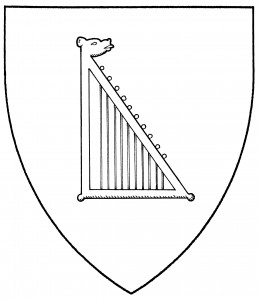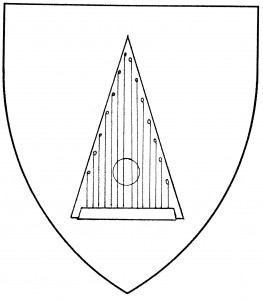A psaltery is a stringed musical instrument, of the same class as the zither, consisting of a flat sound-box with many strings stretched across it. The shape of the sound-box determined the length of the strings, which in turn determined their note; hence the most usual forms of early psaltery were triangular (as in the illustration, taken from an 11th C. manuscript) or trapezoidal. By the 14th Century, however, the “pig-snouted psaltery” or instrumento di porco had developed, as seen in the Luttrell Psalter, c.1340. All were played by plucking, with the fingers or a plectrum.
Society armory includes another form of psaltery, the “bowed psaltery”. Shaped as an isosceles triangle, it’s actually a modern folk instrument played with a musical bow. This form has been disallowed, pending evidence of its period existence.
All forms of psaltery have their strings affronty by Society default; when blazoned “proper”, the psaltery is brown, the color of wood.
Orrick of Romney bears: Azure, a wooden pig-snout psaltery inverted between three acorns proper.
Alyce Renée of Montauban bears: Per bend sinister embattled argent and azure, a frog rampant to sinister and a trapezoidal psaltery bendwise sinister counterchanged.
Eowyn nic Wie of Kincora bears: Gules, a bowed psaltery Or between two flaunches ermine and in chief a psaltery bow Or.


